Whey vs Casein Protein Powder: Which is Better?

The Mayo Clinic suggests that those who lift weights regularly or who are training for an endurance event should aim to consume 1.2–1.7 grams of protein per kilogram of body weight each day. As getting so much protein from real foods can be challenging, whey and casein protein powders are widely used for those looking to increase their protein intake and enhance their muscle growth and recovery following endurance or resistance training. Below, we look at the scientific evidence to explore their similarities and differences in terms of their amino acid levels, speed of digestion, and potential for supporting muscle building and recovery, as well as overall health.
Table 1. Calories and Micronutrients per 100 Grams of Protein Powders From Optimum Nutrition (ON), Myprotein (MP), Grenade, and Bodybuilding Warehouse (BW)
| Supplement | Calories | Protein | Carbs | Fat | Rating |
| ON Whey Concentrate (Amazon) | 378 | 79 | 5.6 | 4.2 | 4.7/5 |
| ON Whey Isolate (Amazon) | 366 | 83 | 4.5 | 1.4 | 4.5/5 |
| ON Serious Mass (Amazon) | 378 | 15 | 75 | 1.7 | 4.4/5 |
| ON Casein Powder (Amazon) | 350 | 74 | 5.8 | 2.5 | 4.5/5 |
| MP Whey Concentrate (Amazon) | 405 | 77 | 8.3 | 7.1 | 4.6/5 |
| MP Whey Isolate (Amazon) | 359 | 81 | 4.6 | 1.1 | 4.6/5 |
| MP Diet Whey (Amazon) | 349 | 61 | 13 | 4.1 | 4.5/5 |
| MP Total Protein** | 388 | 81 | 4.4 | 4.9 | 4.5/5 |
| MP Casein Powder | 350 | 82 | 4.7 | 1.2 | 4.2/5 |
| Grenade Whey Protein (Amazon) | 370 | 78 | 1.9 | 1.8 | 4.7/5 |
| BW Whey Concentrate (Amazon) | 375 | 80 | 4.7 | 5.7 | 4.4/5 |
| BW Whey Isolate (Amazon) | 374 | 90 | 1.0 | 1.0 | 3.6/5 |
| BW Pure Casein | 375 | 78 | 13.1 | 1.1 | NA |
| BW Casein Hydrolysate | 320 | 85 | 0 | 0 | NA |
As shown in the table, Optimum Nutrition's whey concentrate and Grenade's whey concentrate are the most highly rated by consumers out of all of the whey and casein protein powders above.
Discover more top-rated protein powders in our article on the most popular vanilla and chocolate powders.
Where Do Whey and Casein Protein Powders Come From?
Whey and casein protein powders both originate from cow's milk. Whey protein is derived from the liquid by-product of cheese production and is separated from the casein content during this process. Casein protein, conversely, is extracted directly from milk and represents the majority of its protein content, being the primary protein found in milk and cheese products.
Amino Acid Profiles
As shown in Figure 1, both whey and casein proteins contain all of the main amino acids, including all essential amino acids and all branch-chain amino acids (1; BCAAs), so both are complete proteins. With respect to the BCAAs, whey protein has 40% more leucine but 18% less isoleucine and 31% less valine than casein protein. Regarding the other essential amino acids, whey protein has 23% more lysine and over double the tryptophan but 43% less histidine, 12% less methionine, 31% less phenylalanine, and 2% less threonine than casein protein.
Figure 1. Grams of Non-Essential, Essential*, and Branched-Chain** Amino Acids per 100 Grams of Whey and Casein Protein
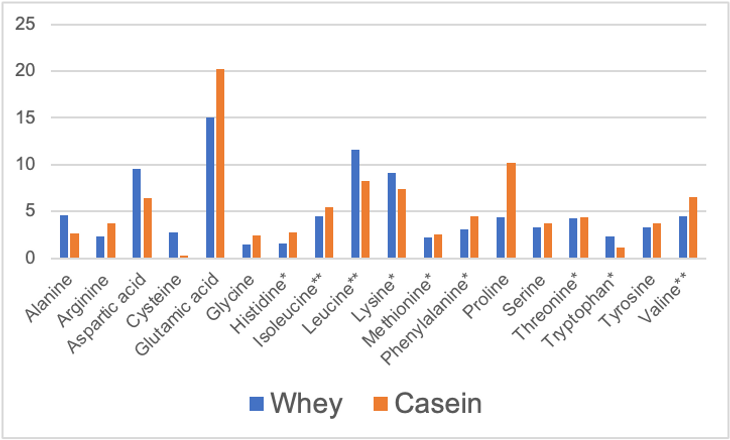
Differences in Branched-Chain Amino Acids
What are the potential implications of these amino acid content differences between whey and casein proteins?
- Leucine: Leucine supplementation can lead to improvements in endurance and power (2). Therefore, the higher concentration of this amino acid in whey protein may be an advantage for those interested in these aspects of athletic performance. However, only small amounts of leucine (e.g., 3.5 grams per day for an 80-kilo individual) are required for such effects, and it's likely that someone supplementing with either whey protein powder or casein protein powder would receive enough since whey and casein proteins contain 11.6 and 8.3 grams of leucine per 100 grams (Figure 2). For instance, a large whey protein shake made from two 30-gram scoops of whey protein concentrate from Myprotein would provide 44 grams of protein, which would be expected to contain over 5 grams of leucine.
Figure 2. Grams of Leucine per 100 Grams of Whey and Casein Protein
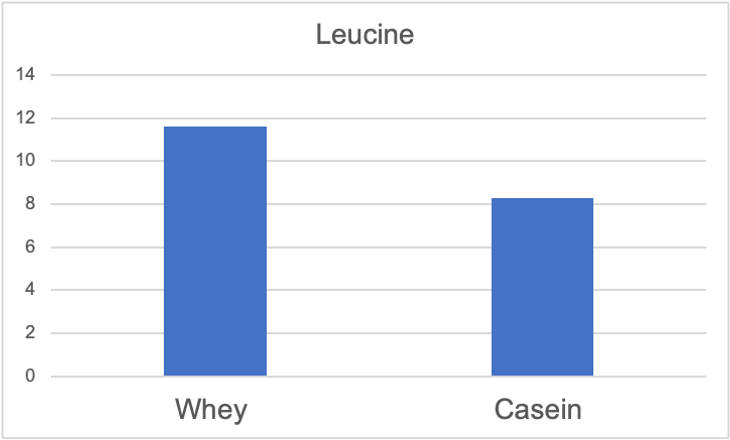
- Isoleucine and Valine: There's little evidence that dietary supplements that only contain isoleucine or valine promote outcomes related to athletic performance (e.g., muscle strength). Reflective of this, BCAA supplements usually have more leucine than isoleucine or valine (e.g., 2:1:1 or 4:1:1 ratios). However, numerous studies provide evidence that supplements combining all of the BCAAs can provide benefits to athletes, such as increased endurance, power, and perceptual–motor skills. Given that both whey and casein proteins provide good amounts of all of the BCAAs, it's unlikely that any differences between the two in terms of the individual BCAA quantities would have substantial implications for your athleticism.
Differences in Other Essential Amino Acids
- Phenylalanine: There's evidence that supplementing with 3 grams of phenylalanine per day can promote fat loss (3) and that consuming 12 grams per day is not associated with any adverse effects (4). Therefore, it's possible that a greater quantity of phenylalanine in casein protein would make it a better option for those focused on weight loss, but whey protein could also provide a sufficient amount, given that it has about 3 grams per 100 grams (Figure 3).
Figure 3. Grams of Phenylalanine per 100 Grams of Whey and Casein Protein
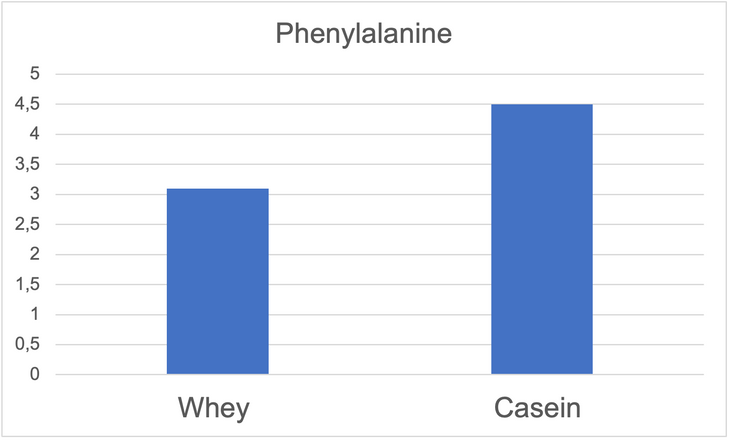
Tryptophan: Some studies suggest that supplementing with about 1 gram of tryptophan per day may lead to improvements in endurance and power (5) and may decrease perceptions of exertion (6). However, other studies have called into question the idea that it improves endurance (7). Regardless, since both whey and casein protein supplements will usually provide at least 1 gram of tryptophan per 100 grams (Figure 4), either could be used to consume enough tryptophan to experience the potential benefits.
Figure 4. Grams of Tryptophan per 100 Grams of Whey and Casein Protein
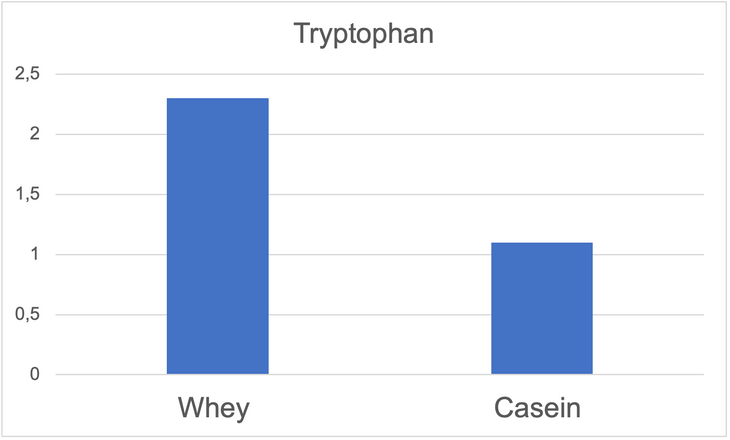
- Histidine, lysine, methionine, threonine: There's little evidence that suggests that supplementing with these amino acids impacts common fitness goals.
If you're concerned about the amino acid profile of your preferred type of protein supplement, you could consider taking an essential amino acid supplement to fill in any gaps. If you're not a fan of protein in a powder form, you could consider picking up some whey-based protein bars.
Differences in Non-Essential Amino Acids
- Arginine: A systematic review and meta-analysis in the journal Nutrients (8) suggests that supplementing with 1.5–2 grams of arginine per day can improve aerobic performance (e.g., during endurance activities) and that supplementing with 10–12 grams per day can improve anaerobic performance (e.g., during weight lifting). As whey and casein proteins contain 2.3 and 3.7 grams of arginine per 100 grams, respectively (Figure 5), getting the 1-5–2 grams needed to see significant aerobic benefits would be easy with either of these proteins. However, getting the 10–12 grams per day needed to see significant anaerobic benefits could be challenging if only relying on whey or casein proteins, so you might need to get additional arginine from other animal proteins, such as those in chicken and turkey, or from plant-based sources (e.g., pumpkin seeds, soy, lentils).
Figure 5. Grams of Arginine per 100 Grams of Whey and Casein Protein
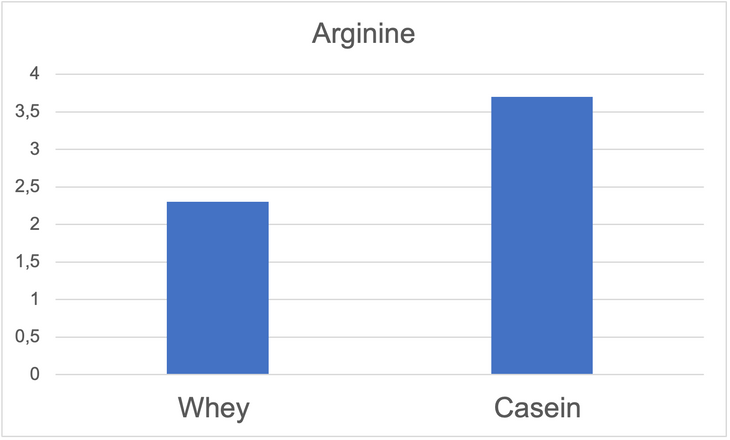
- Cysteine: There's evidence that supplementing with 0.5 grams of cysteine per day can reduce muscle damage following exercise (9). Since whey and casein proteins contain 2.8 and 0.3 grams of cysteine per 100 grams*, respectively (Figure 6), it would be a lot easier to get 0.5 grams by using a whey protein concentrate or a whey protein isolate compared to casein supplements.
Figure 6. Grams of Cysteine per 100 Grams of Whey and Casein Protein
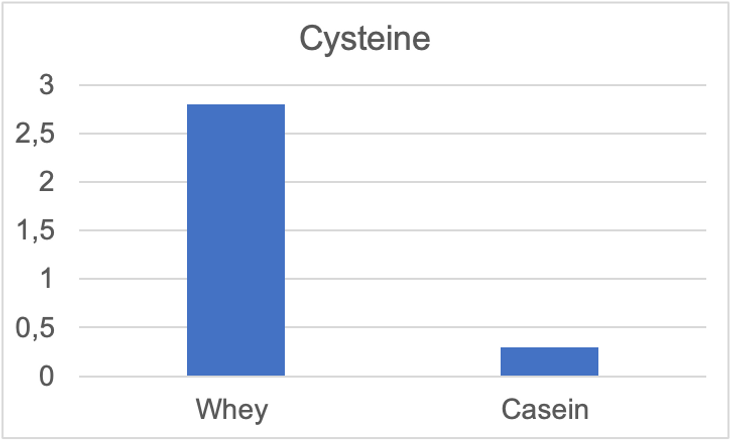
- Glutamic acid: Lots of studies link glutamine, a derivative of glutamic acid, to sports-related outcomes. For instance, studies show that glutamine supplementation can reduce muscle damage after team sports (10) and can minimise the risk of infection following endurance events (11). Additionally, research (12) suggests that supplementing with 0.35 grams of glutamine per kilo of body weight per day can increase muscular power and strength and lead to improvements in body composition (e.g., less fat and more muscle mass). As men in the UK weigh about 80 kilos on average, one might require up to 28 grams of glutamine per day to see such effects. Since not all glutamic acid becomes glutamine and since whey and casein proteins provide 15 and 20.2 grams of glutamic acid per 100 grams, respectively (Figure 7), getting enough glutamine from either would be challenging. However, glutamine is abundant in a range of foods, such as dairy products like cottage cheese, meats like beef and pork, and plants like spinach and cabbage, so these could be consumed alongside supplements to increase glutamine intake.
Figure 7. Grams of Glutamic Acid per 100 Grams of Whey and Casein Protein
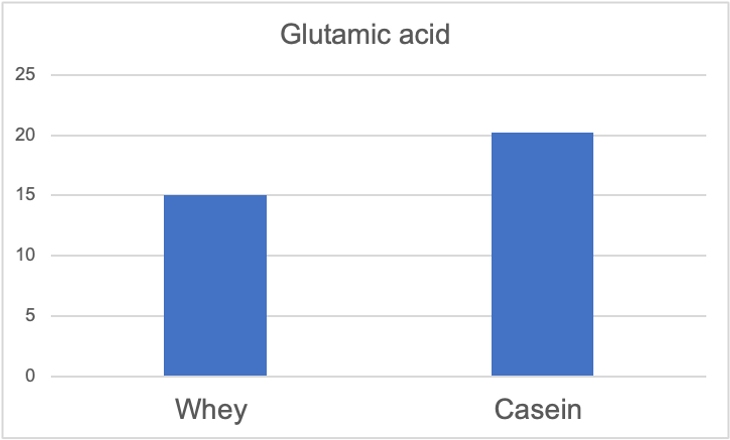
- Serine: There's little evidence that serine supplements by themselves increase athletic performance, but serine has been linked to reduced fatigue during exercise when taken as a supplement combining 3.6 grams of arginine, 2.2 grams of valine, and 0.2 grams of serine (13). Per 100 grams, whey and casein proteins contain 2.3 and 3.7 grams of arginine, 4.6 and 6.5 grams of valine, and 3.3 and 3.7 grams of serine, respectively (Figure 8). Therefore, it would be easy to get enough valine or serine from either whey or casein, but you would need to consume a lot of whey concentrate or whey isolate to get 3.6 grams of arginine.
Figure 8. Grams of Serine per 100 Grams of Whey and Casein Protein
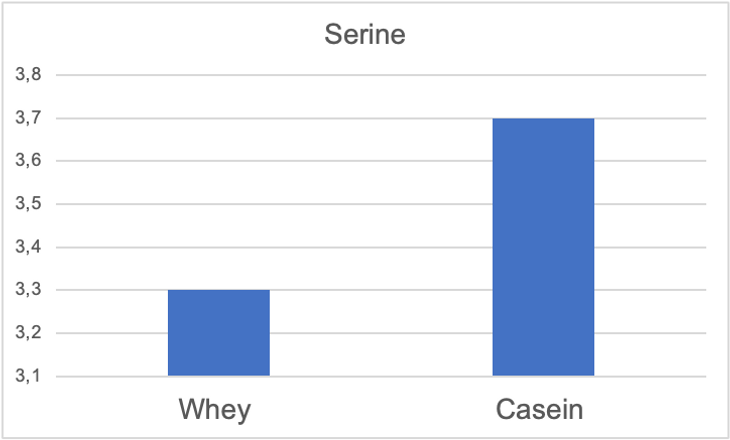
- Tyrosine: 0.15 grams of tyrosine per kilo of body weight has been linked to improved endurance (14). A male in the UK of average weight (about 80 kg), therefore, might require 12 grams to experience such an effect. As whey and casein proteins only provide 3.3 and 3.7 grams of tyrosine per 100 grams, respectively (Figure 9), it would be challenging to get 12 grams from either, so you would need to get it from tyrosine-rich foods, like peanut butter, almond butter, and fish.
Figure 9. Grams of Tyrosine per 100 Grams of Whey and Casein Protein
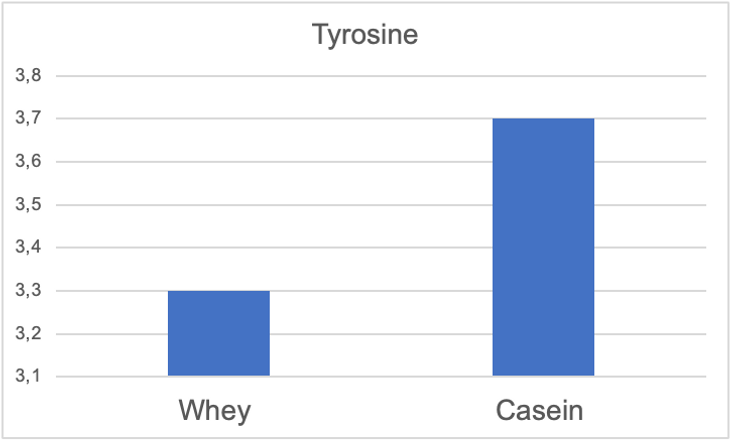
- Alanine, aspartic acid, glycine, and proline: There's little evidence that suggests that supplementing with these amino acids impacts common fitness goals.
Differences in Digestion Rate?
Perhaps the main difference between whey and casein proteins with regard to how they are processed by the body is their rate of digestion.
Whey protein, known for its water solubility and rapid absorption, is often referred to as a fast-digesting protein. This leads to a swift rise in amino acid levels in the bloodstream following whey protein ingestion (15). In contrast, casein protein, which is not water-soluble and tends to coagulate, is considered a slow-digesting protein. This results in a steady release of amino acids, maintaining elevated amino acid levels in the body over an extended duration (16).
Below, we look at differences in athletic performance outcomes associated with whey and casein protein supplementation, some of which may relate to differences in the rate of digestion.
Differences in Muscle Protein Synthesis?
Muscle protein synthesis (MPS) is the biological process through which cells construct muscle proteins, essential for muscle growth, repair, and maintenance, thereby playing a pivotal role in enhancing strength and athletic performance.
A study published in the Journal of Applied Physiology (17) found that whey protein stimulated MPS significantly more than micellar casein (the least processed form of casein) both at rest and after resistance exercise. At rest, MPS was 93% greater with whey compared to casein. Within a 3-hour window after exercise, whey's effect on MPS was 122% greater than that of casein. Consistent with this, levels of essential amino acids in the blood were substantially higher 30 and 60 minutes after taking whey compared to casein.
However, these levels were slightly lower between 2 and 3 hours after taking whey compared to casein, supporting the perspective that casein provides a more steady stream of amino acids (Figure 10).
Figure 10. Essential Amino Acid Concentrations in Blood (nmol/ml-1) Following Casein vs Whey Protein Across 30-Minute Intervals
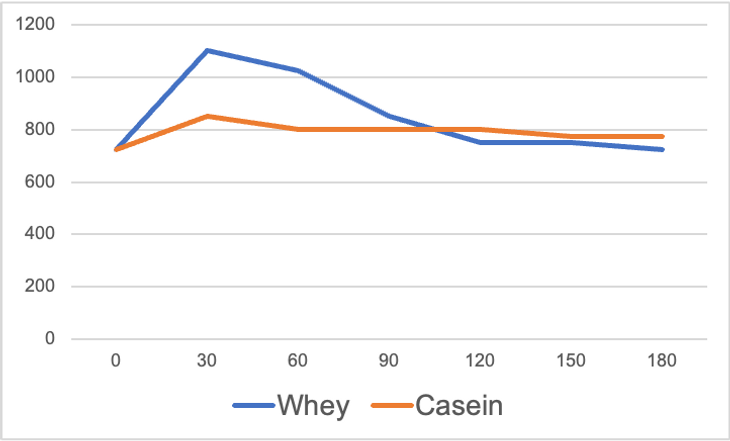
A similar study published in the American Journal of Physiology-Endocrinology and Metabolism (18) looked at essential amino acid levels and MPS for a longer period after whey or casein consumption following resistance training.
As with the other study, the researchers found that essential amino acid levels in blood were significantly higher shortly after whey consumption compared to casein consumption. However, between 3 and 6 hours after consumption, levels were higher among those who had taken casein compared to whey, again suggesting that casein provides a slow release of amino acids. While MPS was still greater overall in the 6-hour post-exercise window among those who had taken whey compared to casein, the effect was less pronounced than that observed in the 3-hour window in the aforementioned study.
Based on results like these, it's often suggested that whey, a fast-acting protein, is preferable post-workout and that casein protein is the best option before periods of fasting, such as during sleep, when it can provide a steady supply of amino acids. However, while research indicates that consuming either protein before bed can increase MPS and decrease protein breakdown during sleep, the extent of MPS doesn't differ across protein types (19).
Differences in Muscle Gain?
The results in the previous section suggest that whey protein, compared to casein protein, may lead to greater muscle protein synthesis, but is this actually reflected in muscle tissue size and strength?
In one study (20), recreational bodybuilders took 1.5 grams of whey or casein protein per kilogram of body weight per day while completing a 10-week resistance training programme. Those in the whey condition experienced significantly greater gains in strength (assessed by 1-rep max on cable pull-downs, squats, and bench press) and lean mass, as well as greater reductions in fat mass.
These results suggest that out of whey and casein proteins, the former may be the best choice for those focused on gaining strength, building muscle, and losing fat.
Differences in Post-Workout Recovery?
A study published in the Journal of Human Sport and Exercise (21) investigated whether there were differences in performance or recovery associated with consuming a whey or casein shake alongside carbohydrates after a 1-hour bike ride at 75% VO₂ max.
Two hours later, the participants rode 20 kilometres as quickly as they could. The results revealed no significant differences in the time taken to reach 20 kilometres between the whey and casein conditions. Additionally, there were no differences between the conditions in levels of creatine kinase (a marker of muscle breakdown).
Thus, while future studies focused on other types of exercise (e.g., resistance training) might identify significant differences, these results do not suggest that one protein is better than the other in terms of muscle recovery.
You might also be interested in my article on the best muscle recovery supplements.
Differences in Mixability?

A scooper from a bag of casein protein (left) and a scooper from a bag of whey protein (right).
As you can see from the photo above, casein and whey proteins have quite different textures. Casein tends to stick to things more, which can cause a mess. It also tends to absorb more liquid, so it can be more difficult to dissolve it in milk or water when making shakes. However, it's fine in smoothies as a blender can help to ensure that it mixes with the liquid properly.
Other Potential Health Benefits of Whey and Casein Proteins
As well as providing athletic benefits, whey and casein protein powders have been linked to more general positive health outcomes.
Blood Pressure
Both whey and casein proteins have been linked to reduced blood pressure. Additionally, whey protein may reduce arterial stiffness. Therefore, these proteins could help to address risk factors for cardiovascular disease (22).
Immune System Function
A study published in the British Journal of Nutrition (23) suggests that whey protein supplementation, but not casein protein supplementation, might have a positive impact on the immune system of patients with chronic liver disease. Whey protein was associated with certain immunomodulatory responses, notably increased levels of particular proteins (e.g., interferon-γ-induced protein-10/CXCL10) and decreased levels of others (e.g., IL-5). It's possible that these results reflect the presence of bioactive peptides (i.e., short chains of amino acids) derived from whey protein.
Antioxidant Effects
Antioxidants are substances that can neutralise free radicals—unstable molecules that cause damage within cells (i.e., that cause oxidative stress). A study published in the Journal of Food and Drug Analysis (24) found that both whey and casein proteins demonstrated a range of antioxidant activities, suggesting that they may be able to help protect the body from oxidative stress, which can accelerate ageing and increase the risk of chronic diseases like diabetes, cancer, and neurodegenerative disorders (25).
Other Considerations
Your calorie intake will differ depending on the type of protein supplement you use, which could have implications for weight loss and weight gain over an extended period. So that you can make the ideal choice for you, see Table 1 for an overview of how popular whey and casein protein supplements compare with respect to their calories and macronutrients.
Conclusion
Thus, the benefits of whey protein and casein can include increases in muscle protein synthesis (MPS), improved muscle repair, and a reduced risk of hypertension. With regard to the muscle-related benefits, these reflect how whey and casein are high-quality proteins with an excellent balance of essential and non-essential amino acids.
Nevertheless, while either could be a great option for those who want to ensure they're getting enough protein, the evidence tends to favour whey protein.
With respect to MPS, although casein may promote a more sustained release of amino acids, whey protein appears to have a greater impact on MPS during the three hours following post-workout consumption, which appears to also be the case when considering a longer period of time (e.g., six hours after). As MPS plays a vital role in muscle development, it's perhaps unsurprising that whey protein has also been linked to superior improvements in strength and body composition, making it an excellent choice for those interested in sports like powerlifting or bodybuilding.
Moreover, whey protein may have some other unique benefits relative to casein powder, as reflected in evidence indicating that it could reduce arterial stiffness and elicit positive immune system responses.
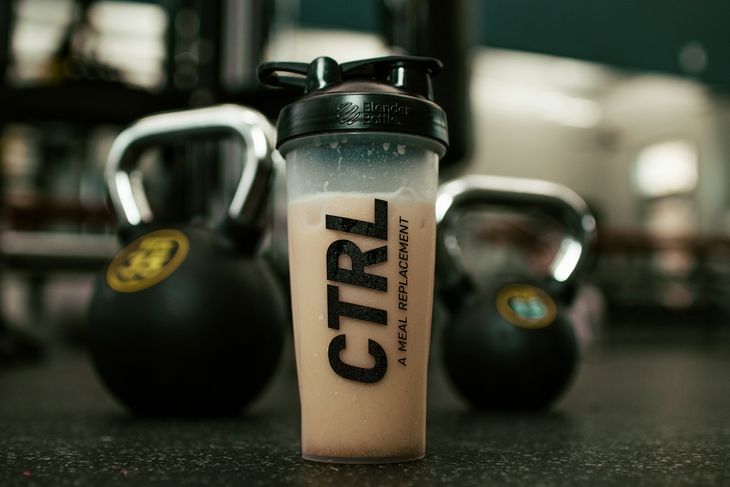
If you have lactose intolerance and need to avoid milk protein, you could consider using a vegan protein powder to help you reach your daily protein requirements. You can learn more about different types of proteins, including plant- and milk-based protein powders, in our articles comparing pea and rice protein, pea, soy, and whey protein, pea and whey protein, collagen and whey protein, hemp and pea protein, mass gainers and whey protein, protein bars and protein powders, plant and whey proteins, and whey and hemp protein. We also consider vegan and non-vegan protein sources in our articles on the best protein supplements for weight loss, weight gain, diabetes, over-40s, and seniors.
To learn about the best ways of reaching your athletic potential with other supplements, check out these articles on how BCAAs compare to pre-workouts, glutamine, and creatine, the ultimate muscle-growing supplements for seniors, how BCAA powder compares with BCAA pills, how creatine compares to whey protein, how EAAs compare with protein, and the benefits of creatine for different types of athlete.
About the Author

Dave Robinson is a co-founder of ukfitness.pro and has a background in psychology (BSc) and neuroscience (MSc, PhD). As well as strength training, he enjoys endurance challenges and has completed marathons and ultramarathons, cycled across several countries, and completed the Three Peaks Challenge. When writing, he draws on scientific evidence to understand the pros and cons of different diets, supplements, and training regimes.
As an Amazon Associate, the site earns from qualifying purchases.
Foot Notes
*The tiny amounts of cysteine in casein protein might make you question whether it's really a complete protein source. However, cysteine is a non-essential amino acid, and a complete protein is usually defined as one that has all essential amino acids, which casein does.
**While the other products in the table could be thought of as "100 percent whey" or "100 percent casein" proteins as they only contain these types of protein, Myprotein's total protein combines a range of proteins, including whey and casein.
References
1. Rasmussen, C.J. (2008). Nutritional Supplements for Endurance Athletes. In: Nutritional Supplements in Sports and Exercise. Humana Press. https://doi.org/10.1007/978-1-59745-231-1_11
2. Crowe, M. J., Weatherson, J. N., & Bowden, B. F. (2006). Effects of dietary leucine supplementation on exercise performance. European journal of applied physiology, 97(6), 664–672. https://doi.org/10.1007/s00421-005-0036-1
3. Ueda, K., Sanbongi, C., Yamaguchi, M., Ikegami, S., Hamaoka, T., & Fujita, S. (2017). The effects of phenylalanine on exercise-induced fat oxidation: a preliminary, double-blind, placebo-controlled, crossover trial. Journal of the International Society of Sports Nutrition, 14, 34. https://doi.org/10.1186/s12970-017-0191-x
4. Miura, N., Matsumoto, H., Cynober, L., Stover, P. J., Elango, R., Kadowaki, M., Bier, D. M., & Smriga, M. (2021). Subchronic Tolerance Trials of Graded Oral Supplementation with Phenylalanine or Serine in Healthy Adults. Nutrients, 13(6), 1976. https://doi.org/10.3390/nu13061976
5.Javierre, C., Segura, R., Ventura, J. L., Suárez, A., & Rosés, J. M. (2010). L-tryptophan supplementation can decrease fatigue perception during an aerobic exercise with supramaximal intercalated anaerobic bouts in young healthy men. The International journal of neuroscience, 120(5), 319–327. https://doi.org/10.3109/00207450903389404
6. Segura, R., & Ventura, J. L. (1988). Effect of L-tryptophan supplementation on exercise performance. International journal of sports medicine, 9(5), 301–305. https://doi.org/10.1055/s-2007-1025027
7. Stensrud, T., Ingjer, F., Holm, H., & Strømme, S. B. (1992). L-tryptophan supplementation does not improve running performance. International journal of sports medicine, 13(6), 481–485. https://doi.org/10.1055/s-2007-1021302
8. Viribay, A., Burgos, J., Fernández-Landa, J., Seco-Calvo, J., & Mielgo-Ayuso, J. (2020). Effects of Arginine Supplementation on Athletic Performance Based on Energy Metabolism: A Systematic Review and Meta-Analysis. Nutrients, 12(5), 1300. https://doi.org/10.3390/nu12051300
9. Tsakiris, S., Parthimos, T., Parthimos, N., Tsakiris, T., & Schulpis, K. H. (2006). The beneficial effect of L-cysteine supplementation on DNA oxidation induced by forced training. Pharmacological research, 53(4), 386–390. https://doi.org/10.1016/j.phrs.2006.01.008
10. Córdova-Martínez, A., Caballero-García, A., Bello, H. J., Pérez-Valdecantos, D., & Roche, E. (2021). Effect of Glutamine Supplementation on Muscular Damage Biomarkers in Professional Basketball Players. Nutrients, 13(6), 2073. https://doi.org/10.3390/nu13062073
11. Castell, L. M., & Newsholme, E. A. (1997). The effects of oral glutamine supplementation on athletes after prolonged, exhaustive exercise. Nutrition (Burbank, Los Angeles County, Calif.), 13(7-8), 738–742. https://doi.org/10.1016/s0899-9007(97)83036-5
12. Hakimi, M., Mohamadi, M. A., & Ghaderi, Z. (2012). The effects of glutamine supplementation on performance and hormonal responses in non-athlete male students during eight week resistance training. Journal of Human Sport and Exercise, 7(4), 770–782. https://doi.org/10.4100/jhse.2012.74.05
13. Tsuda, Y., Yamaguchi, M., Noma, T., Okaya, E., & Itoh, H. (2019). Combined Effect of Arginine, Valine, and Serine on Exercise-Induced Fatigue in Healthy Volunteers: A Randomized, Double-Blinded, Placebo-Controlled Crossover Study. Nutrients, 11(4), 862. https://doi.org/10.3390/nu11040862
14. Tumilty, L., Davison, G., Beckmann, M., & Thatcher, R. (2011). Oral tyrosine supplementation improves exercise capacity in the heat. European journal of applied physiology, 111(12), 2941–2950. https://doi.org/10.1007/s00421-011-1921-4
15. Campbell, B., Kreider, R. B., Ziegenfuss, T., La Bounty, P., Roberts, M., Burke, D., Landis, J., Lopez, H., & Antonio, J. (2007). International Society of Sports Nutrition position stand: protein and exercise. Journal of the International Society of Sports Nutrition, 4, 8. https://doi.org/10.1186/1550-2783-4-8
16. Wilson, J., & Wilson, G. J. (2006). Contemporary issues in protein requirements and consumption for resistance trained athletes. Journal of the International Society of Sports Nutrition, 3(1), 7–27. https://doi.org/10.1186/1550-2783-3-1-7
17. Tang, J. E., Moore, D. R., Kujbida, G. W., Tarnopolsky, M. A., & Phillips, S. M. (2009). Ingestion of whey hydrolysate, casein, or soy protein isolate: effects on mixed muscle protein synthesis at rest and following resistance exercise in young men. Journal of applied physiology (Bethesda, Md. : 1985), 107(3), 987–992. https://doi.org/10.1152/japplphysiol.00076.2009
18. Reitelseder, S., Agergaard, J., Doessing, S., Helmark, I. C., Lund, P., Kristensen, N. B., Frystyk, J., Flyvbjerg, A., Schjerling, P., van Hall, G., Kjaer, M., & Holm, L. (2011). Whey and casein labeled with L-[1-13C]leucine and muscle protein synthesis: effect of resistance exercise and protein ingestion. American journal of physiology. Endocrinology and metabolism, 300(1), E231–E242. https://doi.org/10.1152/ajpendo.00513.2010
19. Trommelen, J., van Lieshout, G. A. A., Pabla, P., Nyakayiru, J., Hendriks, F. K., Senden, J. M., Goessens, J. P. B., van Kranenburg, J. M. X., Gijsen, A. P., Verdijk, L. B., de Groot, L. C. P. G. M., & van Loon, L. J. C. (2023). Pre-sleep Protein Ingestion Increases Mitochondrial Protein Synthesis Rates During Overnight Recovery from Endurance Exercise: A Randomized Controlled Trial. Sports medicine (Auckland, N.Z.), 53(7), 1445–1455. https://doi.org/10.1007/s40279-023-01822-3
20. Cribb, P. J., Williams, A. D., Carey, M. F., & Hayes, A. (2006). The effect of whey isolate and resistance training on strength, body composition, and plasma glutamine. International journal of sport nutrition and exercise metabolism, 16(5), 494–509. https://doi.org/10.1123/ijsnem.16.5.494
21. Cepero, M., Padial, R., Rojas, F. J., Geerlings, A., De la Cruz, J. C., & Boza, J. J. (2010). Influence of ingesting casein protein and whey protein carbohydrate beverages on recovery and performance of an endurance cycling test. Journal of Human Sport and Exercise, 5(2), 158–175. https://doi.org/10.4100/jhse.2010.52.06
22. Fekete, Á. A., Givens, D. I., & Lovegrove, J. A. (2013). The impact of milk proteins and peptides on blood pressure and vascular function: a review of evidence from human intervention studies. Nutrition research reviews, 26(2), 177–190. https://doi.org/10.1017/S0954422413000139
23. Mizubuti, Y. G. G., Vieira, E. L. M., Silva, T. A., d'Alessandro, M. O., Generoso, S. V., Teixeira, A. L., Lima, A. S., & Correia, M. I. T. D. (2021). Comparing the effects of whey and casein supplementation on nutritional status and immune parameters in patients with chronic liver disease: a randomised double-blind controlled trial. The British journal of nutrition, 125(7), 768–779. https://doi.org/10.1017/S0007114520003219
24. Chiang, S.H., & Chang, C.Y. (2005). Antioxidant properties of caseins and whey proteins from colostrums. Journal of Food and Drug Analysis, 13(1), 57-63.
25. Liguori, I., Russo, G., Curcio, F., Bulli, G., Aran, L., Della-Morte, D., Gargiulo, G., Testa, G., Cacciatore, F., Bonaduce, D., & Abete, P. (2018). Oxidative stress, aging, and diseases. Clinical interventions in aging, 13, 757–772. https://doi.org/10.2147/CIA.S158513